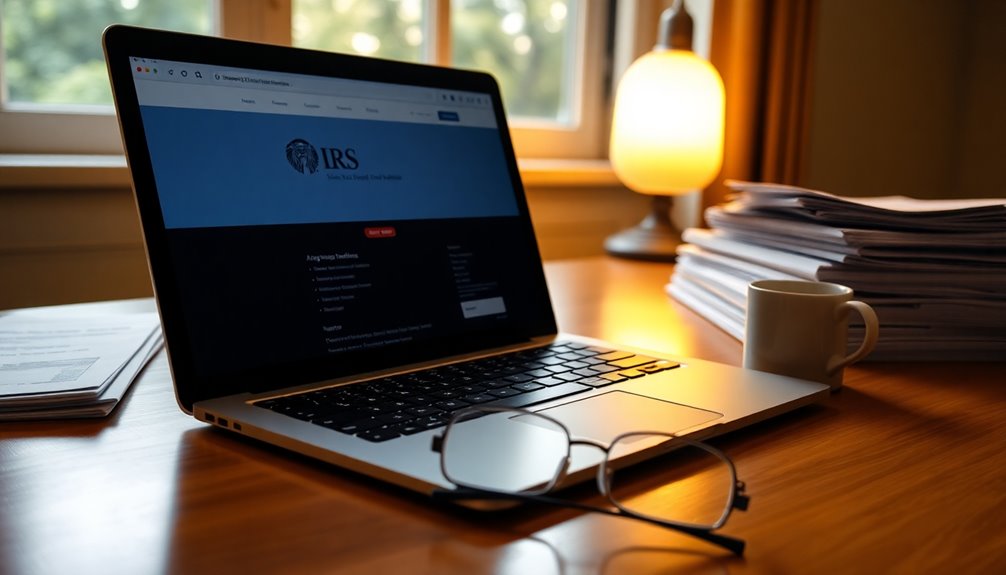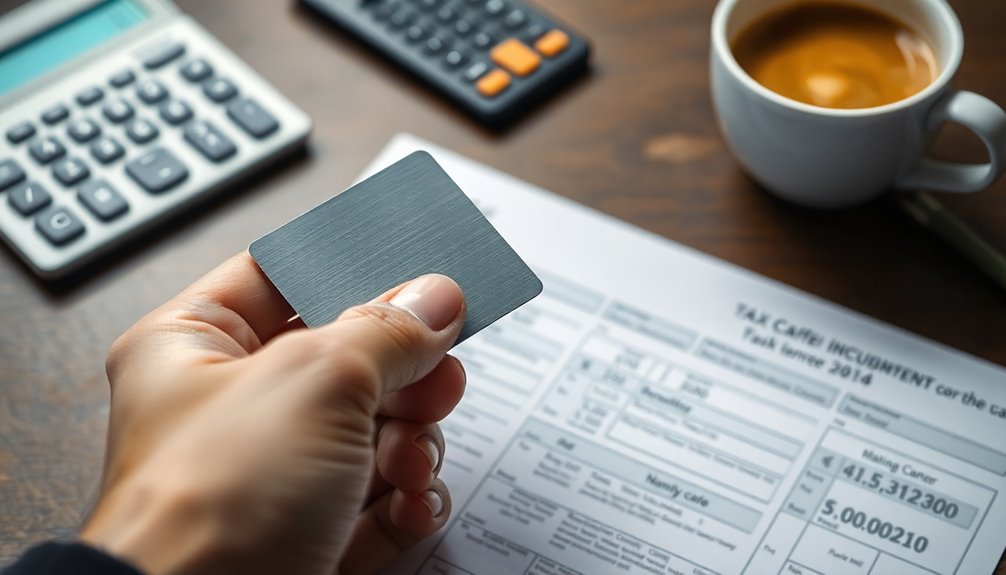To check if you owe taxes, start by setting up or logging into your IRS online account at IRS.gov. You'll need your email, SSN or ITIN, and a photo ID. Once you're in, you can view your tax balance, payment history, and recent tax returns. If you don't have online access, you can call the IRS at 1-800-829-1040 for assistance. You should also review any IRS notices you've received, as they often indicate amounts owed. Staying informed about your tax obligations is crucial, and there's more to discover about managing your taxes efficiently.
Key Takeaways
- Create an IRS online account at IRS.gov to view your tax account details, including amounts owed and payment history.
- Review your most recent tax return and prior filings to identify any outstanding balances or discrepancies.
- Use IRS online tools to check for pending actions like liens or levies that may indicate tax liabilities.
- Call the IRS Tax Help Line at 1-800-829-1040 for personalized assistance with your tax obligations.
- Regularly monitor IRS notices and correspondence for updates on owed taxes, penalties, and payment deadlines.
Setting Up an IRS Online Account

Setting up your IRS online account is a straightforward process that can provide you with essential tax information at your fingertips. To get started, you'll need a few key items: a valid email address, your Social Security Number (SSN) or Individual Tax Identification Number (ITIN), and a photo ID like a driver's license or passport. Having a mobile phone with a camera handy is also important.
Begin by visiting IRS.gov and selecting "View your account" or "Login to your Online Account." Choose "Create an account" and register with ID.me. You'll set up a login email and password, then accept ID.me's terms.
Next, select a multi-factor authentication option for added security. For identity verification, you can upload your photo ID and take a video selfie or connect with an ID.me agent via video chat. Make sure to enter your Social Security Number and confirm your phone number and email.
Once your account is set up, you can access information from your most recent tax return, view tax transcripts, check amounts owed, and even set up online payment agreements. Additionally, this account allows you to access your most recent and three prior federal tax returns, which is invaluable for managing your tax-related tasks.
Calling the IRS for Assistance

If you need further assistance after setting up your IRS online account, calling the IRS can be a helpful next step. For individual tax questions, dial the IRS Tax Help Line at 1-800-829-1040, available from 7:00 a.m. to 10:00 p.m. local time on weekdays and 10:00 a.m. to 3:00 p.m. on Saturdays during tax season. You can ask about federal tax returns and get answers to your inquiries, including checking your refund status. It's important to remember that the IRS has three years to assess discrepancies in your tax filings.
If you're a business owner, reach out to the Business and Specialty Tax Line at 1-800-829-4933, also available from 7:00 a.m. to 10:00 p.m. on weekdays. This line helps with various business taxes and applying for an Employer Identification Number (EIN).
For checking your refund status, you can call the Refund Hotline at 1-800-829-1954. You'll need to provide your filing status and the exact expected refund amount.
Be prepared for long wait times, as many others may be seeking assistance too. Remember, you can also check the IRS website for additional resources.
Reviewing Old IRS Notices

When reviewing old IRS notices, it's crucial to understand their significance in assessing any potential tax liabilities you may owe. Each notice serves a specific purpose, and recognizing them can help you take appropriate action.
For instance, a Balance Due Notice details the exact amount of tax you owe for a particular year, including any penalties or interest accrued. Make sure to note the payment due date to avoid further complications. Remember that full payment before the due date avoids initial penalties.
If you receive a Threat of Tax Lien notice, it warns you about potential liens on your property if the debt isn't paid. This notice may also offer payment plan options, so don't ignore it.
Additionally, if you see a notice regarding Tax Refund and Debt Fulfillment, it means your refund will be applied to your outstanding tax debt, which could partially or fully settle what you owe.
Lastly, a Seizure of Property notice indicates that the IRS may take your assets unless you resolve the debt promptly. Understanding these notices empowers you to respond effectively and manage your tax situation.
Always keep copies of these notices for your records and future reference.
Consulting a Tax Professional

Consulting a tax professional can be a smart move if you're feeling overwhelmed by your tax situation. Many firms offer free initial consultations, where a case manager will review your tax debt and financial details. They'll discuss potential strategies for tax relief and help assess your financial hardship and ability to pay.
Tax consultants provide a range of services, including preparing tax returns and identifying deductions to lower your tax burden. They can assist with complex issues, like taxes on rental income, and help manage the implications of life events such as marriages or divorces. Additionally, it's important to be aware that many tax settlement firms often misrepresent their qualifications and may not have actual IRS experience, which could impact the outcome of your case.
Often, these professionals are certified public accountants (CPAs) or enrolled agents (EAs), bringing valuable expertise in tax planning and current law changes.
While initial fees can range from $3,000 to $6,000, understanding the fee structure is crucial. This might include additional costs as the process unfolds. A tax professional will also identify necessary documents you'll need, ensuring you're well-prepared throughout the process.
Utilizing IRS Online Tools

Navigating your tax situation doesn't end with consulting a tax professional; utilizing IRS online tools can further simplify the process. Start by signing in or creating an online account on the IRS website. This account allows you to view essential tax information, including the amount you owe, your balance for each tax year, and your payment history. Additionally, having an Intuit account is required for expert connection, ensuring you have access to personalized support options.
You can also access your tax records, which detail the returns you've filed with the IRS. If you're concerned about pending actions, like liens or levies, you can find that information too. For a more in-depth understanding, consider requesting tax transcripts. There are three types available: Account, Wage and Income, and Return transcripts. Each provides different details about your financial status and income.
Additionally, the IRS offers self-service tools that let you manage your tax account online. You can make payments, view your payment history, and download necessary forms.
Lastly, keep in mind that the IRS website may not show the amount owed until your tax return processes, so check your return form for precise figures.
Exploring Other Verification Methods

Exploring various verification methods can help you confirm whether you owe taxes and understand your financial obligations. One effective approach is to check with tax preparers or use tax preparation software. Tax preparers can give you accurate information on any taxes owed during the filing process, while many software programs offer tools that calculate your tax obligations directly. Some even connect to IRS systems for real-time verification. Additionally, using IRS Direct Pay is a convenient way to verify and make payments directly from your bank account without any registration required. Furthermore, understanding state-specific tax implications, such as those for IRA withdrawals, can give you a clearer picture of your overall tax liability.
Another way is to review IRS correspondence. The IRS sends notices when taxes are owed or payments are overdue, detailing the amount owed, penalties, and interest. Keeping records of these documents can help you track outstanding debts.
If you prefer direct communication, contacting the IRS is a solid option. You can call their customer service for detailed information about your tax account or visit a local Taxpayer Assistance Center.
Lastly, utilize your financial institutions or payment processors. They can confirm any payments made to the IRS, helping you ensure everything is processed correctly.
Frequently Asked Questions
Can I Check My Tax Balance if I Am Not a U.S. Citizen?
Yes, you can check your tax balance even if you're not a U.S. citizen.
First, gather your documents, including any income statements and tax identification numbers.
Visit the IRS website or your state's tax agency site to access your account. You may need to create an account or log in using your information.
This will help you review your tax obligations and ensure you're on track with any payments due.
What Should I Do if My Tax Information Is Incorrect?
If your tax information's incorrect, start by identifying the specific error on your return.
Gather all relevant documents, like W-2s and 1099s, and compare them to your original filing.
Then, use IRS Form 1040-X to amend your return.
Provide a clear explanation for the correction and submit it to the appropriate IRS service center.
Don't forget to include any necessary payment to avoid penalties or interest.
Correcting mistakes promptly is crucial!
How Often Is My Tax Liability Information Updated by the IRS?
Your tax liability information's updated differently based on how you filed.
If you e-filed, expect updates every 24 hours, usually overnight, and you can check within 36 hours after filing.
Paper returns, however, only update weekly on Wednesdays, with updates available at least four weeks after mailing.
Since processing times for paper returns are longer, you won't see daily updates like you do for e-filed returns.
Are There Fees for Using a Tax Professional to Check My Account?
Yes, there are fees for using a tax professional to check your account.
These fees vary based on the type of return you need help with and the preparer's experience. For example, a standard Form 1040 might cost around $220, while more complex returns can exceed $300.
If you're dealing with multiple schedules or special circumstances, expect the fees to rise accordingly.
It's important to choose a service that fits your needs.
Can I Check My Tax Status if I Filed Jointly With My Spouse?
Yes, you can check your tax status if you filed jointly with your spouse.
You'll need to access the IRS website and use tools like "Where's My Refund?" or log into your IRS account.
Both you and your spouse are equally responsible for the return, so ensure you have all relevant information handy.
It's a good idea to review your combined income and deductions to see where you stand financially.
Conclusion
In conclusion, checking if you owe taxes doesn't have to be stressful. By setting up an IRS online account, calling for assistance, or reviewing past notices, you can easily get the information you need. Don't hesitate to consult a tax professional if you're unsure, and take advantage of online tools. With these steps, you'll gain clarity on your tax situation and ensure you're on the right track for any payments due. Stay informed and proactive!









